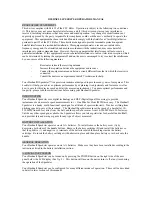
Exalt Installation and Management Guide
ExtendAir (TDD) Series Digital Microwave Radios
50
203591-010
2012-09-04
System Configuration Page
This page contains several critical system parameters.
Figure 27 System Configuration page
Most entries on this page are self-explanatory. The following lists unique or important parameters.
•
Set the Endpoint Identifier so that one end of the link is set to Radio A and the opposite end set to
Radio B. In single-link networks, it is unimportant which end is designated A or B. In multi-link
networks, however, it may be important to orient the links so that at any collocation site (where
there are multiple radios of the same type at the same site), all radios are set to the same Endpoint
Identifier (A or B). See
Link Orientation and Synchronization
•
Set the Radio Transmit Power (dBm) parameter to the designed level. The professional installer
sets this value or dictates the value of this setting to the system administrator following the system
design and local regulations. In many cases, this value must be set to a proper value to comply
with legal restrictions. Improper values can result in liability to the user and/or installer.
–
Do not adjust the Radio Transmit Power parameter to a value higher than is legally allowed.
–
Do not adjust the Radio Transmit Power parameter lower than the link budget and fade margin
can afford.
Note:
For models requiring a Regulatory Domain Key (RDK), you must enter a valid RDK to
edit this page.
Note:
Changing the Endpoint Identifier parameter requires a reboot of the radio to take effect.
The reboot temporarily interrupts traffic.
Note:
Changing Radio Transmit Power
may
temporarily interrupt traffic
. Small changes
in output power do not normally interrupt traffic, but larger changes may.
















































